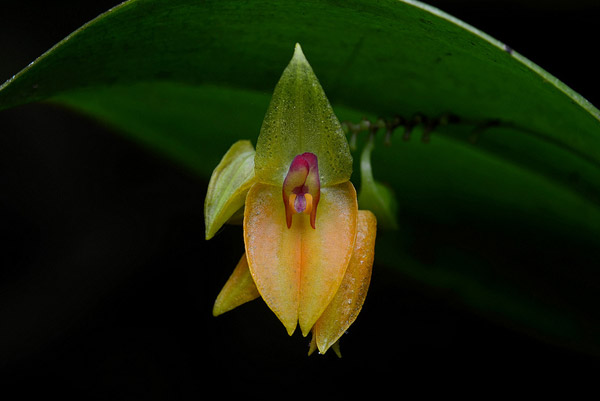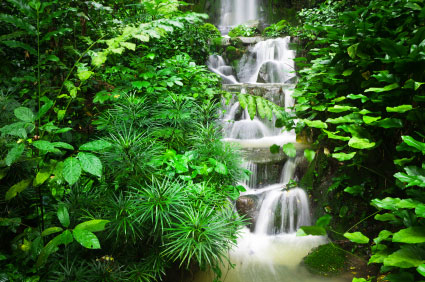Infected Butterflies Lead Geneticists Up the Garden Path
 Some animal species look so alike that external characteristics do not provide sufficient information about whether they belong to the same species or not. "The animal species themselves on the other hand can certainly tell the difference, as it is crucial for their reproductive success," says Sylvia Ritter, PhD student from the Department of Community Ecology at the UFZ. In addition to external characteristics, odours and behaviour also play an important role. However, scientific investigations on species-specific odours and behaviour are very complex. "This is why for species that cannot be differentiated using standard methods, genetic techniques such as DNA barcoding are used," explains UFZ researcher Dr. Martin Wiemers. With DNA barcoding, certain sections of the mitochondrial DNA (mtDNA) are examined -- that is the genetic makeup, which is not found in the nucleus of the cell, but located in the mitochondria which are the cell's organelles residing in the cytoplasm. If divergences of more than two per cent are found between two potentially different species, then this is regarded as an indication of so-called cryptic speciation.
Some animal species look so alike that external characteristics do not provide sufficient information about whether they belong to the same species or not. "The animal species themselves on the other hand can certainly tell the difference, as it is crucial for their reproductive success," says Sylvia Ritter, PhD student from the Department of Community Ecology at the UFZ. In addition to external characteristics, odours and behaviour also play an important role. However, scientific investigations on species-specific odours and behaviour are very complex. "This is why for species that cannot be differentiated using standard methods, genetic techniques such as DNA barcoding are used," explains UFZ researcher Dr. Martin Wiemers. With DNA barcoding, certain sections of the mitochondrial DNA (mtDNA) are examined -- that is the genetic makeup, which is not found in the nucleus of the cell, but located in the mitochondria which are the cell's organelles residing in the cytoplasm. If divergences of more than two per cent are found between two potentially different species, then this is regarded as an indication of so-called cryptic speciation.
"Genetic studies of two parasitic butterfly species from the same genus of Large Blues suspect cryptic speciation, as great divergences were found in their mtDNA," says Wiemers. Together with Sylvia Ritter (first author of the article), the team supporting Martin Wiemers, Walter Durka, Josef Settele and Stefan Michalski has conducted studies on the Scarce Large Blue (Phengaris teleius) and the Dusky Large Blue (Phengaris nausithous) across their entire Eurasian distribution range. In addition to sections of mtDNA used in DNA barcoding, the researchers also compared nuclear DNA found in the nucleus of the cell. Furthermore, individuals were tested for infections with the so-called Wolbachia bacteria, as an infection with these bacteria can lead to the fact that the mtDNA of infected individuals will strongly differ from the mtDNA of non-infected Large Blues.
"We found very strong divergences in the mtDNA, which can be an indication of cryptic speciation. However, in the nuclear DNA markers there were no such differences, which would be near to impossible if we were dealing with different species," says Ritter. "We were able to find a significant correlation between the differences in mtDNA and Wolbachia infections. Hence, Wolbachia infections can be said to mimic cryptic speciation."
In some insect groups up to 70 per cent of all species are infected with Wolbachia bacteria. Up until now however there has been no standard testing for Wolbachia infections when DNA barcoding was carried out. "This could lead to cryptic species being found that do not actually exist. Particularly in the case of insects, we therefore recommend the additional testing of nuclear DNA so that investigations on cryptic species do not lead to false results. For species conservation it is also important to be able to differentiate between species because with their different characteristics they mostly have different habitat requirements," says Wiemers.
The Large Blues under investigation are particularly vulnerable species, since they not only depend on a specific food plant -- the great burnet (Sanguisorba officinalis), but also on specific ant species. The larvae of these Large Blues feed on the eggs and larvae of these host ants and even adopt a "cuckoo strategy" whereby they mimic the ants´ chemical substances in order to get the ants to feed them. Even the slightest changes in land use can lead to an absence in the necessary combination of food plant and host ants, causing the Large Blues to vanish from the ecosystem completely. According to Wiemers: "If we are to conserve a species, we first have to recognise what its needs are. A prerequisite for this on the other hand is to know which species we are dealing with. Only in this way can we proceed to implement meaningful measures for species conservation and species reintroduction programs."
Climate change could kill off Andean cloud forests, home to thousands of species found nowhere else
 One of the richest ecosystems on the planet may not survive a hotter climate without human help, according to a sobering new paper in the open source journal PLoS ONE. Although little-studied compared to lowland rainforests, the cloud forests of the Andes are known to harbor explosions of life, including thousands of species found nowhere else. Many of these species—from airy ferns to beautiful orchids to tiny frogs—thrive in small ranges that are temperature-dependent. But what happens when the climate heats up?
One of the richest ecosystems on the planet may not survive a hotter climate without human help, according to a sobering new paper in the open source journal PLoS ONE. Although little-studied compared to lowland rainforests, the cloud forests of the Andes are known to harbor explosions of life, including thousands of species found nowhere else. Many of these species—from airy ferns to beautiful orchids to tiny frogs—thrive in small ranges that are temperature-dependent. But what happens when the climate heats up? "Shifts in temperature will require upslope migration for most species to remain in equilibrium with climate and therefore potentially avoid extinction," the scientists write in the paper.
However looking at aerial photos and satellite imagery of Manu National Park from 1963 to 2005, the researchers found that Andean cloud forests may run into an insurmountable border as they attempt to migrate up mountain sides: puna grasslands. Although the temperature has warmed significantly since the 1960s, the researchers found that the treeline bordering the Andean cloud forests and high-altitude grasslands had hardly moved. In fact, according to the research, 80 percent of this border remained stable in the study area since 1963. This transition area between one ecosystem (cloud forest) and another (puna grasslands) is known to scientists as an ecotone.
While Andean trees are already moving rapidly upslope in response to climate change, they have not been able yet to penetrate the ecotone barrier, according to the study. The scientists aren't certain why the puna grasslands aren't making way for cloud forests more rapidly as temperatures rise, but it appears that this colonization needs considerably more time than cloud forests species have under current climate predictions.
"From a biological perspective, cloud forest tree seedlings have major difficulty establishing themselves in puna grassland," lead author David Lutz explained to mongabay.com. "The exact reasons why are still a subject of debate among plant physiologists, but generally field work has found the survival of tree seedlings to be low when exposed to the open sky in puna. Instead, tree seedlings fare far better under the forest canopy, indicating that a slow prolonged march, generation by generation, has been the typical mode of movement, often out from isolated patches who weathered the change in climate in a sheltered spot."
In the past, cloud forests were able to make this march, as climate changed relatively slowly. But the pace of climate change today could simply outstrip the forests ability to migrate into the grasslands, notes Lutz.
"From a biological perspective, cloud forest tree seedlings have major difficulty establishing themselves in puna grassland," lead author David Lutz explained to mongabay.com. "The exact reasons why are still a subject of debate among plant physiologists, but generally field work has found the survival of tree seedlings to be low when exposed to the open sky in puna. Instead, tree seedlings fare far better under the forest canopy, indicating that a slow prolonged march, generation by generation, has been the typical mode of movement, often out from isolated patches who weathered the change in climate in a sheltered spot."
In the past, cloud forests were able to make this march, as climate changed relatively slowly. But the pace of climate change today could simply outstrip the forests ability to migrate into the grasslands, notes Lutz.
Losing just one pollinator species leads to big plant declines
 A shocking new study finds that losing just one pollinator species could lead to major declines in plant productivity, a finding that has broad implications for biodiversity conservation. Looking at ten bumblebee species in Colorado alpine meadows, two scientists found that removing a single bee species cut flower seed production by one-third. Pollinators worldwide are in major trouble as they are hit by habitat loss, pesticides, disease and other impacts. In fact, the EU has recently banned several pesticides that have been linked to the global bee decline.
A shocking new study finds that losing just one pollinator species could lead to major declines in plant productivity, a finding that has broad implications for biodiversity conservation. Looking at ten bumblebee species in Colorado alpine meadows, two scientists found that removing a single bee species cut flower seed production by one-third. Pollinators worldwide are in major trouble as they are hit by habitat loss, pesticides, disease and other impacts. In fact, the EU has recently banned several pesticides that have been linked to the global bee decline. "We found that these wildflowers produce one-third fewer seeds in the absence of just one bumblebee species," says lead author Berry Brosi, with Emory University. "That's alarming, and suggests that global declines in pollinators could have a bigger impact on flowering plants and food crops than was previously realized."
The study's results, conducted in-the-field, contradicts past studies that have argued that plants would remain relatively unscathed in a world of fewer pollinators, so long as remaining pollinators picked up the slack. However, those past studies have depended solely on computer modeling; this new study is the first to test that hypotheses in real world conditions.
Brosi and his team set up plots at the Rocky Mountain Biological Laboratory in Colorado at 9,500 feet. In control plots, all ten bumblebee species were allowed to forage, while in other plots specific species were removed by net. A team of researchers then tracked the bees as they interacted with a flower called larkspurs.
"We'd literally follow around the bumblebees as they foraged," explains co-author Heather Briggs with the University of California-Santa Cruz. "It's challenging because the bees can fly pretty fast."
Sprinkled with pollen, buzzing bees fly from one blossom to another, collecting sweet nectar from brilliantly colored flowers. Bees tend to symbolize the pollination process, but there are many wild insects that carry out the same function. Unfortunately, wild insect populations are in decline, and, according to a recent study, adding more honey bees may not be a viable solution.
Creatures like beetles, flies, butterflies and wild bees pollinate flowers before they can develop into mature fruits and seeds, or a fruit set. This is an especially valuable process to the agricultural industry as the system ultimately boosts the number of harvested crops.
"All around the world people are looking for ways to make agricultural production more efficient," said co-author Saul Cunningham, a researcher with the Commonwealth Scientific and Industrial Research Organization in Australia. Cunningham was one of fifty researchers from across the globe that contributed to the study published recently in Science.
"At the same time there is global concern that biodiversity loss is continuing at a dangerous rate," Cunningham continued.
Creatures like beetles, flies, butterflies and wild bees pollinate flowers before they can develop into mature fruits and seeds, or a fruit set. This is an especially valuable process to the agricultural industry as the system ultimately boosts the number of harvested crops.
"All around the world people are looking for ways to make agricultural production more efficient," said co-author Saul Cunningham, a researcher with the Commonwealth Scientific and Industrial Research Organization in Australia. Cunningham was one of fifty researchers from across the globe that contributed to the study published recently in Science.
"At the same time there is global concern that biodiversity loss is continuing at a dangerous rate," Cunningham continued.
Forests and grasslands once neighbored agricultural landscapes, providing habitats for wild insect pollinators. The insects would visit nearby crop fields, enhancing the pollination process. Nature manages the pollination process at no cost to humans, branding wild insect pollination as an "ecosystem service."
But as the number of adjacent habitats has declined, so has the abundance and diversity of the wild insects that once lived there, resulting in fewer crop visits. According to the study, the pollination of crop flowers by wild insects is a vulnerable service.
Honey bees have long been viewed as a substitute for vanishing wild pollinators. Some crops like almond, blueberry or watermelon are routinely stocked with a high number of bees to promote and improve pollination, a tradition that crosses continental boundaries. However, the idea of honey bees replacing abundant and diverse wild insects is not well understood.
"Our study challenges the widespread assumption that crop pollination services provided by wild insects can be replaced by a single domesticated species, the honey bee, without a loss in crop production," said Rachael Winfree with Rutgers University in New Jersey, a contributing scientist to the study.
The researchers analyzed data from 600 fields, hitting every continent on which food is grown. The group observed 41 crop systems, ranging from annual and perennial fruits, seeds and nuts to stimulant crops like coffee. Some fields contained an assortment of crops while others were monocultures with only one crop.
The insect species and abundance were also diverse. Several crops were stocked with a high number of honey bees; others had a variety of wild insects. The researchers measured flower visitation for each species of insect and calculated pollen deposition.
"The results were impressive," said Lucas Garibaldi with the Universidad Nacional de Río Negro in Argentina, lead researcher of the study. "We found that wild insects consistently enhanced the number of flowers setting fruits or seeds for a broad range of crops and agricultural practices on all continents with farmland."
Based on the study's findings, wild insects pollinated crops more effectively due to more visitations. In fields with a low number of wild insects the fruit set was also much lower.
Managed honey bees supplemented the pollination process, but did not take the place of the wild insects. In fact, relying on a single pollinator like the honey bee could be detrimental to the crops if pathogens, predators or pesticides ravage the insect population, which has been observed during the Colony Collapse Disorder of honey bees in the U.S. and Europe.
If wild insect pollinators continue to decline in agricultural landscapes, crop harvests may be negatively affected. The study suggests that farmers move to more sustainable management practices that include both honey bees and diverse wild insects, such as the conservation or restoration of neighboring natural habitats to promote natural pollinators.
Source: http://news.mongabay.com/2013/0403-avery-wild-pollinators.html
But as the number of adjacent habitats has declined, so has the abundance and diversity of the wild insects that once lived there, resulting in fewer crop visits. According to the study, the pollination of crop flowers by wild insects is a vulnerable service.
Honey bees have long been viewed as a substitute for vanishing wild pollinators. Some crops like almond, blueberry or watermelon are routinely stocked with a high number of bees to promote and improve pollination, a tradition that crosses continental boundaries. However, the idea of honey bees replacing abundant and diverse wild insects is not well understood.
"Our study challenges the widespread assumption that crop pollination services provided by wild insects can be replaced by a single domesticated species, the honey bee, without a loss in crop production," said Rachael Winfree with Rutgers University in New Jersey, a contributing scientist to the study.
The researchers analyzed data from 600 fields, hitting every continent on which food is grown. The group observed 41 crop systems, ranging from annual and perennial fruits, seeds and nuts to stimulant crops like coffee. Some fields contained an assortment of crops while others were monocultures with only one crop.
The insect species and abundance were also diverse. Several crops were stocked with a high number of honey bees; others had a variety of wild insects. The researchers measured flower visitation for each species of insect and calculated pollen deposition.
"The results were impressive," said Lucas Garibaldi with the Universidad Nacional de Río Negro in Argentina, lead researcher of the study. "We found that wild insects consistently enhanced the number of flowers setting fruits or seeds for a broad range of crops and agricultural practices on all continents with farmland."
Based on the study's findings, wild insects pollinated crops more effectively due to more visitations. In fields with a low number of wild insects the fruit set was also much lower.
Managed honey bees supplemented the pollination process, but did not take the place of the wild insects. In fact, relying on a single pollinator like the honey bee could be detrimental to the crops if pathogens, predators or pesticides ravage the insect population, which has been observed during the Colony Collapse Disorder of honey bees in the U.S. and Europe.
If wild insect pollinators continue to decline in agricultural landscapes, crop harvests may be negatively affected. The study suggests that farmers move to more sustainable management practices that include both honey bees and diverse wild insects, such as the conservation or restoration of neighboring natural habitats to promote natural pollinators.
Source: http://news.mongabay.com/2013/0403-avery-wild-pollinators.html














